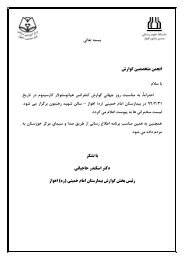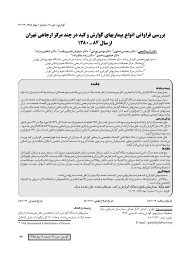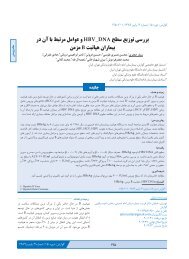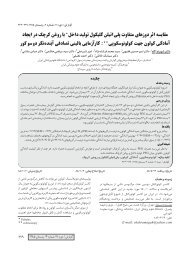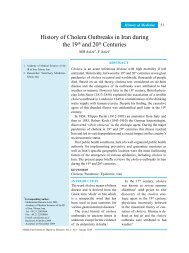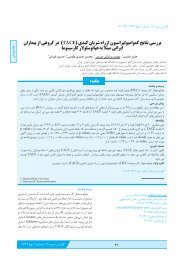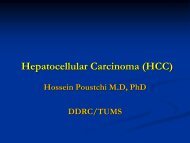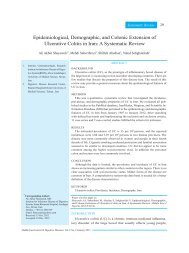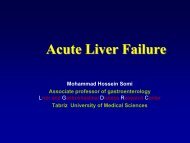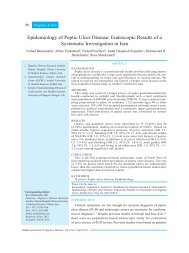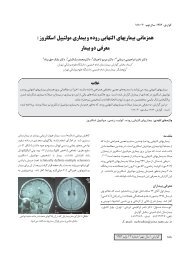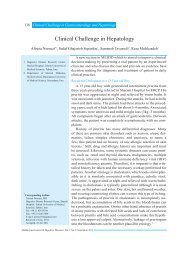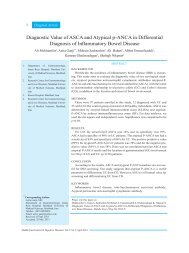Gallbladder Stones - IAGH
Gallbladder Stones - IAGH
Gallbladder Stones - IAGH
Create successful ePaper yourself
Turn your PDF publications into a flip-book with our unique Google optimized e-Paper software.
Gallstone Disease<br />
Farhad Zamani<br />
Associated professor of Gastroenterology and Hepatology<br />
IUMS<br />
GILDRC<br />
Zamani.farhad@gmail.com
Epidemiology<br />
• Gallstones (GS) have existed for more than<br />
35 centuries.<br />
– They have been documented in Egyptian<br />
mummies<br />
• 20 million Americans have GS<br />
• 700,000 cholecystectomys performed<br />
annually in the U.S.<br />
• Most common gastrointestinal disorder<br />
requiring hospitalization
Prevalence<br />
• GS disease increases with age in both sexes<br />
• GS are more common in women at every age<br />
» 22.4% of women aged 60-69<br />
» 11.5% of men aged 60-69<br />
• For each 10 year period after age 40 the<br />
incidence of new GS formation is 3%<br />
• Cholesterol GS common in developed countries<br />
• Pigmented GS common in developing countries
Ethnic Variation<br />
• Prevalence varies with ethnicity<br />
» Highest rates in North American Caucasians, Pima<br />
Indians, Swedish<br />
» Lowest rates in Asian and Sub-Saharan African<br />
• Suggests a role for both genetics and<br />
environmental influences in the<br />
pathogenesis of GS
Gallstone Pathogenesis<br />
Cholesterol and Pigmented GS<br />
Lithogenic<br />
Bile<br />
Nucleation<br />
Stasis<br />
GS<br />
Formation
Cholesterol GS<br />
• Mechansims of cholesterol GS formation<br />
– Hypersecretion of cholesterol into bile<br />
– Hyposecretion of bile acids into bile<br />
– Nucleation factors<br />
– <strong>Gallbladder</strong> mucin<br />
– Role of gallbladder
Cholesterol Solubilization<br />
• Free cholesterol is insoluble in bile, requires<br />
Bile acids and Phospholipids<br />
• Mixed micelles<br />
– Cholesterol, phospholipid and bile acids<br />
• Unilamellar vesicles<br />
– Cholesterol and phospholipid<br />
– Relatively unstable, cholesterol rich and<br />
nucleation prone<br />
– Predominantly formed during bile stasis<br />
– Generate Multi-lamellar vesicles
Mechanisms of GS Formation<br />
•Cholesterol Hyper-secretion<br />
•Bile acid Hypo-secretion
Cholesterol Hyper-secretion<br />
• Obesity<br />
– Increased hepatic<br />
synthesis<br />
– Increased dietary<br />
cholesterol<br />
• Hormones<br />
– Estrogens, OCP’s<br />
– Decreased conversion<br />
to cholesterol esters<br />
– Increased hepatic<br />
uptake<br />
• Genetic<br />
– Increased transport and<br />
uptake<br />
– ↓ 7- ά -hydroxylase<br />
activity (↓BA production)<br />
• Rapid Weight Loss<br />
– Mobilization of cholesterol<br />
stores<br />
• Advancing Age
Bile Acid Hypo-secretion<br />
• Ileal Disease<br />
– Loss of enterohepatic circulation of bile acids<br />
• Congenital<br />
– 12 hydroxylase deficiency, results in decreased<br />
production of BA<br />
• Cholestatic liver diseases<br />
– PBC<br />
– PSC
Lithogenic Bile<br />
• Patients may have problems with both<br />
Hyper-secretion and Hypo-secretion<br />
• The net effect of these disorders is to<br />
produce a bile that is supersaturated with<br />
cholesterol and poor in bile acids<br />
• These conditions favor cholesterol GS<br />
formation
Nucleation (promoters)<br />
• Nucleation is an early and indispensable<br />
step in GS formation<br />
• Promote vesicular fusion and solid<br />
cholesterol crystal formation<br />
• Biliary proteins bind pigment, cholesterol<br />
crystals and phospholipid
<strong>Gallbladder</strong> (GB)<br />
• Important in the pathogenesis<br />
• GB concentrates BA<br />
– Results in viscous bile<br />
– Promotes nucleation<br />
• Secretes mucin<br />
– Promoter<br />
• GB motility plays a vital role<br />
– Normally GB contraction expels sludge and stones<br />
– GB hypo-motility results in stasis of bile<br />
– Promotes sludge and stone formation<br />
• Cholecystectomy prevents recurrent cholelithiasis
• microlithiasis<br />
Biliary Sludge<br />
• microcrystals seen on histologic examination of<br />
a fresh bile specimen<br />
• calcium salts, cholesterol crystals and mucin gel<br />
• U/S<br />
– Low amplitude echo without post-acoustic<br />
shadowing (as seen in stones) that layers with gravity<br />
• May represent an early stage in stone formation<br />
– 18% resolve<br />
– 14% GS<br />
– 19% acalculous cholecystitis
Cholesterol Gallstone
Pigmented Gallstones<br />
• Classifed as Brown or Black pigmented<br />
• Similar underlying mechansims in cholesterol<br />
stone formation<br />
– Lithogenic Bile<br />
– Nucleation<br />
– Stasis<br />
• Predominantly bilirubin pigments and calcium<br />
salts, rather than cholesterol<br />
• Pathogenesis involves deconjugation and<br />
precipitation of bilirubin
Characteristics of Pigmented GS<br />
Characteristic Black GS Brown GS<br />
Size < 1cm > 1cm<br />
Location <strong>Gallbladder</strong> Bile ducts<br />
Association<br />
Hemolysis,<br />
Cirrhosis<br />
Cholangitis,<br />
Parasites<br />
Culture Sterile Bacteria, Ova<br />
Composition<br />
Bilirubin, Calcium<br />
salts<br />
Bilirubin, fatty<br />
acids, cholesterol
Black Pigmented <strong>Stones</strong>
Brown Pigmented <strong>Stones</strong>
Pigmented Gallstones
Risk factors<br />
Age<br />
Gender<br />
2.9 F/M at 30-39 y<br />
1.6 F/M at 40-49 y<br />
1.2 F/M at 50-59 y<br />
FH and genetics : 2-5 times<br />
Obesity : Increase cholesterol synthesis<br />
Serum lipid : Increase in ↑TG. and apolipoprotein,<br />
no associated to cholesterol level
Risk Factors<br />
Pregnancy :<br />
qualitative change of BA → increased chenodeoxyelolate<br />
60% sludge and 30% stone less than l cm resolves after delivery<br />
Sex Hormone :<br />
Progesterone → reduction in BA secretion, slowing GB emptying<br />
Estrogen → increase cholesterol secretion
Risk factors<br />
• Drugs: Clofibrate , ceftriaxone<br />
• Rapid weight loss :gastric by pass ,UDCA dec. risk<br />
• Diabetes mellitus : 2 times, mostly in women
Risk Factors<br />
• Cirrhosis :<br />
• Reduced hepatic synthesis and transport of BA<br />
• High estrogen level<br />
• Impaired GB contraction to meal<br />
• <strong>Gallbladder</strong> stasis :<br />
• Spinal cord injury<br />
• prolonged fasting<br />
• TPN<br />
• Somatostatin ( ↓ CCK)
Protective factors<br />
• Ascorbic acid :<br />
protective in women ?<br />
Cholesterol catabolism?<br />
• Coffee:<br />
moderate coffee consumption<br />
decreased 40% symptomatic gallstone
Chronic cholcystitis<br />
• A pathologist term to describe chronic<br />
inflammatory cell infiltration of the<br />
gallbladder seen on histopathology<br />
• Invariably associated with GS<br />
• May be result of mechanical irritation or<br />
recurrent attacks of acute cholecystitis
Chronic cholcystitis<br />
• Its presence does not correlate with symptoms<br />
• Extensive chronic inflammatory may have only<br />
minimal symptoms<br />
• No evidence that chronic cholecystitis<br />
increases the risk for future morbidity<br />
• Clinical significance is questionable



